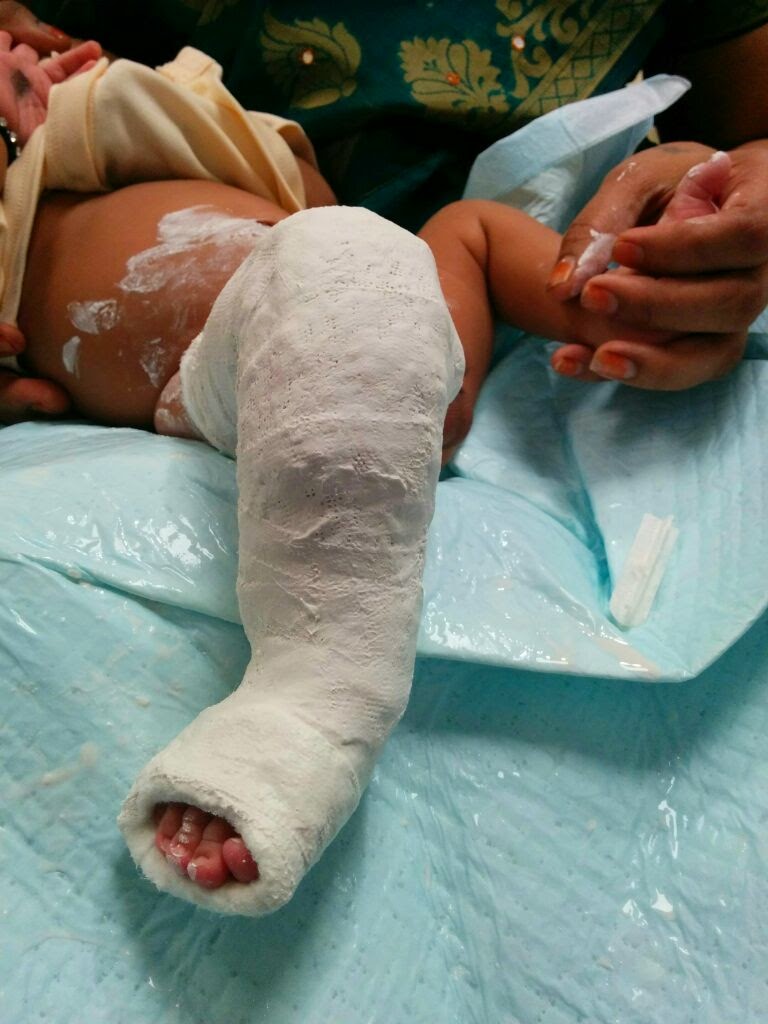Clubfoot Treatments.
Clubfoot Treatments at AMGH
Although Clubfoot is a rare condition, as far as congenital conditions go, it is the most commonly seen musculoskeletal condition among newborns. A congenital condition is an abnormality that is seen at birth, i.e, babies are born with these defects.
Approximately 4 babies amongst every 1000 live births are born with clubfoot, that is, with the foot twisted out of shape or out of the correct position. Clubfoot occurs because the tissues connecting the baby’s muscles to the bones are not long enough or well-developed enough for the foot to be in the right position.
Recognizing Clubfoot
How can parents recognize when their child has clubfoot?
The first thing to understand here is that clubfoot may have varying degrees of severity. In the most severe cases, walking is seriously hampered or inhibited for a child, so parents may have to explore multiple treatment options to get their child the help they need.
The other signs of clubfoot can include one or more of the following:
- Underdeveloped calf muscles.
- The foot or the leg with the deformation usually looks shorter than the other, normally developed foot.
- The deformed foot may be pointing downward and inward, which creates a pronounced arch and turns the heel inwards.
Risk Factors for Developing Clubfoot
Risk factors for clubfoot are more often than not related to a child’s genes and family history. Many times, it has been observed that a child develops clubfoot if one or both of the parents have also developed the condition. While clubfoot is usually seen as an isolated defect, i.e. it does not always indicate the presence of another defect with it, it can sometimes be associated with other congenital conditions or defects. Additionally, a child may develop clubfoot if the mother smokes or is around a lot of cigarette smoke during pregnancy.Clubfoot Treatment
Usually, clubfoot is diagnosed on sight by the doctor, either when the baby is in the womb or as soon as the baby is born. Treatment options may be suggested or begin soon after the baby’s birth since the child’s joints and tendons are extremely flexible then. The objective of the treatment is to affect an improvement in the child’s foot positioning so that long-term disabilities can be prevented. Over the years, many treatment options have been developed and evolved, which include extensive open surgeries and external fixator solutions. However, both of these treatment options can leave the child in a lot of pain and create considerable difficulty with walking.The Ponseti Treatment Method
In contrast to painful surgeries and other painful solutions is the Ponseti Treatment method, which is a time-tested protocol developed by Ignatio Von Ponseti from Iowa. The Ponseti Treatment has been reported to be easy, effective, and reproducible across the world and has delivered proven results for children all over. With the Ponseti Treatment, the doctor works to move the baby’s foot into the correct position and then places it in a cast for stability. The baby’s foot is repositioned and recast once a week for several months before the doctor prescribes braces. The protocol for these braces must be followed strictly if the child is to recover and find normal movement. While it does feel cumbersome and tedious in the beginning, strict adherence to the protocol definitely pays off for the child in the long run. It is the vision of the DHS and the AMGH that this hospital will establish itself as a new paradigm in the provision of health care, particularly to the marginalized through accessible, affordable, available, accountable, and ethical practices.


‘Appu Anantha Jayanth’a Paada is AMGH’s Free Clubfoot Treatment program which wishes to serve families with humble backgrounds.
At Annaswamy Mudaliar General Hospital, as part of our non-profit initiatives, children with clubfoot have been receiving the Ponseti treatment for the last 6 years. Families come here from different walks and far-off places every Sunday morning for plasters and follow-up.
Needless to say, the treatment has been subsidized to help patients.
Parents can avail the Free Clubfoot treatment at AMGH by contacting the hospital and scheduling an appointment for Dr Girish Kumar.
About Dr. Girish Kumar
Dr. Girish Kumar is a trained and practicing Paediatric Orthopaedic Surgeon in Bangalore. He specializes in treating children with Clubfoot, Hip disorders, Fractures and dislocations, Bone and joint infections, and Cerebral Palsy.
Dr. Girish has completed his medical schooling at Kempegowda Institute of Medical Sciences, Bangalore, and Masters in Orthopaedic Surgery from Mysore Medical College.

